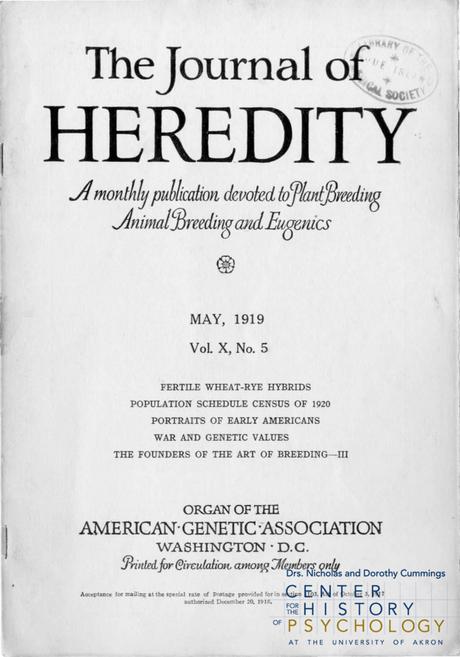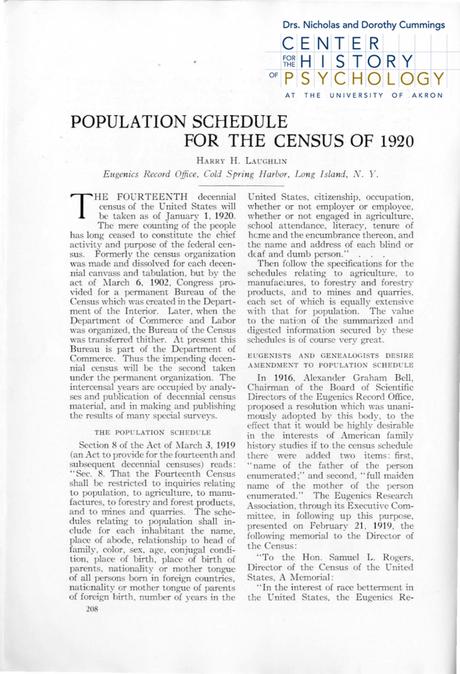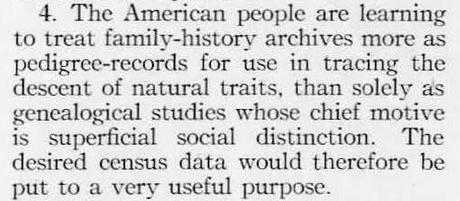contributed by Lizette Royer Barton.
The United States conducts a census every ten years with the goal of counting every single resident of the U.S. The data is used to determine disbursement of all kinds of federal monies and even more importantly, it determines the number of representatives each state gets in the U.S. House of Representatives. Participating in the census is super important so if you haven’t done it yet, get to it for pete sakes! See here.
So census data is used for distributing money and determining representation – good things! – but could that same data be used for not-so-good things? What do you think?
I did a search for “census” across our collections and ended up going way, way down the rabbit hole.
It all started here:

What is the Journal of Heredity? It’s the official journal of the American Genetic Association, a group that is still very much active today researching genetics. Of course, “American breeding and eugenics” has long since left their journal, their research, and their mission but in 1919 eugenics was considered true science by many and its influence on politics and policy, along with numerous other facets of America life, can’t be denied.
First things first, how to access this journal. We have a short run of this title in the archives’ Books and Periodicals collection. We digitized the pre-1923 volumes and they are available in full-text in the online repository here. These early journals are really incredible in regards to plant variety and genetics (seriously, do a search for pawpaws!). And they’re also very interesting in regards to the history of immigration and American life. Do some browsing and have some fun!
Ok, back to the census and the article I want you to read. You can access it via a shared OneDrive folder here,- The Journal of Heredity, May 1919, Vol. X, No. 5. (skip ahead to page 18 of the pdf).

I think this article is an excellent jumping off point to have a discussion with your students about eugenics and eugenicists’ influence on American life, especially immigration policy.
I mentioned a shared OneDrive folder above. In that folder you’ll find The Journal of Heredity and document analysis sheets for each of the following project ideas. Access everything here: CCHP Pandemic Projects: Eugenics and the Census.
Project 1: Have your students read the article and report back. What was most interesting? What was surprising? What would you like to know more about? What questions do you have?
Project 2: Focus on the census. What data was collected on the 1920 census versus the data being collected on the 2020 census. Is the same data being collected? If not, what is different? Any ideas why certain questions are no longer asked?
Project 3: What was the ERO lobbying for to be included on the census and why? Why would “pedigree studies” be important to eugenicists?
Here is a clue:

Project 4: A document analysis that is less about the content of this particular article and more about Harry H. Laughlin and the Eugenics Record Office. And if that’s something of interest you could also assign this article (It is excellent!) – Allen, G. E. (1986). The Eugenics Record Office at Cold Spring Harbor, 1910-1940: An Essay in Institutional History. Osiris, Vol. 2, 225-264.
Project 5: An investigation of how census data and eugenics influenced and shaped the Immigration Act of 1924 (aka the Johnson-Reed Act). For those of you that didn’t know, the Johnson-Reed Act enacted quotas on immigration, not to mention it banned immigrants from Asia all together. How does the census fit in? The quotas on immigrants were based on census data! Specifically, 2% of the U.S. population of immigrants from their country of origin as recorded via the 1890 census was used as the basis of the quota of immigrants that would be accepted from that country starting in 1924.
Allen (1986) is a valuable resource for this one too since it dives deep into Laughlin’s “lobbying” on behalf of eugenics, notably that he testified before the House Committee on Immigration and Naturalization. You could also read Milestones, 1921-1936 from the Office of the Historian . And check out this awesome resource from DOCSTeach via the National Archives – The Impact of the Immigration Act of 1924. This is more geared towards students in grades 7-12 but it’s pretty cool and all of us, regardless of age, could benefit from that resource.
Some things to think about and ask your students:
(1) Why did they go all the way back to the 1890 census to get those population numbers instead of more recent data? Ask your students to do some initial research on immigration in the United States between 1890-1924. Were there large influxes of immigrants coming from specific countries?
(2) What was the effect of these quotas on immigration numbers? Were some countries more affected than others? How did those 1890s numbers affect specific groups?
(3) Were these quotas adjusted throughout the 1930s and 1940s in order to take into account the mass exodus of people fleeing Nazi Germany? Most folks would say, “Yes. of course. The United States wouldn’t keep these quotas and turn away Jewish immigrants.” But is that the truth? Ask your students to answer that question.
(4) Are there any parallels today? I’m sure your students can dig up examples of how both so much, and so little, has changed in the discussion of immigrants and immigration in America.
A note to instructors and students: we would love to hear back from you if you have used any of these projects in class. Your feedback helps us as we continue to develop archival projects that can be completed remotely.
As always, if you’d like to work together to create a more concrete project using the Journal of Heredity please reach out to me directly – [email protected]. I’m happy to help!
